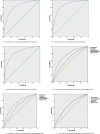The Predictive Value of Personality Traits for Psychological Problems (Stress, Anxiety and Depression): Results from a Large Population Based Study
- PMID: 30864753
- PMCID: PMC7377556
- DOI: 10.2991/j.jegh.2017.11.003
The Predictive Value of Personality Traits for Psychological Problems (Stress, Anxiety and Depression): Results from a Large Population Based Study
Abstract
The current study aimed to determine the prognostic values of personality traits for common psychological problems in a large sample of Iranian adult. In a large sample of healthy people (n = 4763) who lived in Isfahan province; the NEO-FFI was used to assess the personality traits; depression and anxiety were assessed using the "Hospital Anxiety and Depression Scale (HADS)" also stress was measured through Persian validated version of General Health Questionnaire (GHQ-12). Receiver Operating Characteristics Curve (ROC) analysis was used as main statistical method for data analysis. ROC analysis showed neuroticism was the best predictor for all psychological problems with highest area under the curve (AUC) (95% confidence interval) for stress, 0.837 (0.837-0.851), anxiety 0.861 (0.847-0.876) and depression 0.833 (0.820-0.846) (p < .001) and the corresponding cut-off points (sensitivity, specificity), were 21.5 (77%, 66%), 22.5 (81%, 77%) and 20.5 (77%, 74%), respectively. Other personality traits were significant protective factors for being affected with psychological problems (p < .001). Similar findings were observed separately in women and men. The present study showed that the neuroticism is significant risk factor for being affected with three psychological problems while other traits are significant protective factors. Personality traits are useful indices for screening psychological problems and an effective pathway toward prevention in general population.
Keywords: Personality traits; ROC analysis; anxiety; depression; stress.
© Atlantis Press International B.V.
Conflict of interest statement
All authors declare that they have no conflict of interests.
Figures


References
Publication types
MeSH terms
LinkOut - more resources
Full Text Sources
Medical
